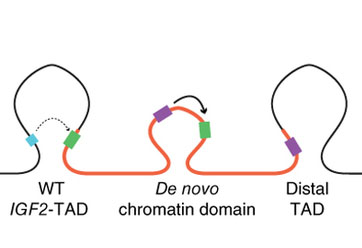
Duplications of different-sized sections of DNA are often found in the genome. How this affects the organism has only been partially investigated. Depending on their location in the genome, such duplications can form new functional units, the so-called "topologically associated domains" (TAD). These are DNA loops, which on average are one million base pairs long and contain one or more genes and their control elements. They control when and in which cells a gene is switched on or off.
Using a specially developed medical informatics method, the researchers systematically investigated the occurrence of gene duplications and the phenomenon of "enhancer kidnapping" on 7,416 previously published cancer genes. They found that hijacking of foreign enhancer elements by carcinogenic genes is a common process in solid tumors, and have now shown this process for the first time in colorectal cancer and lung cancer. The scientists from the NCT Heidelberg, the DKTK, EMBL and the German Cancer Research Center (DKFZ) took a closer look at a well-known marker for particularly aggressive and chemotherapy-resistant cancer forms, the IGF2 gene (insulin-like growth factor 2). "We noticed that IGF2 was over 250 times more active in approximately 6 to 7 percent of colorectal cancer patients than in healthy control cells. And this, although the gene was not significantly more common in their DNA", reports Professor Hanno Glimm, physician and scientist at the NCT, DKFZ and the DKTK. The scientists discovered in the analysis of the three-dimensional structure of the genome, why this genetic information was present so often: within one genetic region, IGF2 had doubled. This tandem structure created a new loop that brought IGF2 close to a whole group of enhancers, also known as the "super-enhancer". The new constellation activated the IGF2 gene to a far greater extent than usual. The research results help to better understand cancer-inducing mechanisms, and can contribute to the development of more targeted therapies against tumors where these investigated changes play a role.
Nature Genetics has published the results of the study. The two corresponding authors are Hanno Glimm of the NCT Heidelberg and DKTK and Jan O. Korbel of EMBL Heidelberg. As an NCT 3.0. Project, this work was funded by the DFG, the Baden-Württemberg Foundation, the Helmholtz Initiative iMed, and German Cancer Aid.
Weischenfeldt J et al. (2016) Pan-cancer analysis of somatic copy-number alterations implicates IRS4 and IGF2 in enhancer hijacking. Nature Genetics DOI: 10.1038/ng.3722
Usage of image material for press releases
The use of this image is free of charge. The NCT Heidelberg permits one-time use in connection with the reporting on the topic of the press release. The following must be provided as picture credits: "Source: Hanno Glimm / Jan Korbel".